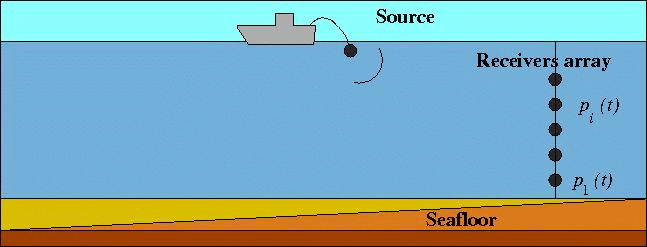154th ASA Meeting, New Orleans, LA
[ Lay Language Paper Index | Press Room ]
Influence of roughness on coherence of signals reflected by the seafloor
Laurent Guillon laurent.guillon@ecole-navale.fr
French Naval Academy
BP 600
29240 Brest Armes, France
Charles W. Holland
Applied Research Laboratory
The Pennsylvania State University
State College, PA 16804
Popular version of paper 2aUWa4
Presented Wednesday morning, November 28, 2007
154th ASA Meeting, New Orleans, LA
For many applications such as habour protection, mine hunting
or biological studies, there is nowadays an increase in the use of
low-frequency sonar (f < 10 kHz) in shallow water areas.
Consequently, there are a lot of interactions between acoustic signals
and the seafloor and these acoustic signals can have a large
penetration into the seafloor. Therefore, it is necessary to
develop tools that can find the geoacoustic nature of the seafloor on
a large vertical scale in order to predict the acoustic propagation and
scattering.

Our
work is based on experiments lead offshore of Italy in 1997 by NURC
(Nato Undersea Research Center) and sketched on this figure : a
broad-band low frequency (200-6000 Hz) acoustic source is towed by a
research ship and the acoustic signals are recorded on a 15-hydrophones
vertical array moored on the seafloor. These experiments have been used
to invert the geoacoustic properties of the seafloor by studying the
reflection coefficient in time and frequency domain.
We
re-read these data with new "glasses", focusing on the "coherence"
of these signals in temporal domain (with the maximum of the
cross-correlation coefficients) and in frequency domain (with the
phase of the cross-spectra). In previous work, it was shown that
these
coherence parameters are very sensitive to the geoacoustic nature of
the
seafloor which may open the door for a new method of probing the seabed
properties on both large scales (i.e., deterministic) and small scales
(i.e., statistical). The aspect examined in this present work is the
influence of the seafloor roughness on the coherence. To do so, the
time series are simulated by a three-step process: 1) computation of
the plane-wave reflection coefficient, 2) computation of the spherical
wave reflection coefficient by a numerical integration of the
Sommerfeld integral, and 3) Inverse Fourier Transform. Using these
simulations, with the measured data as a guide, the potential for
detecting and extracting roughness estimates from the coherence in
complex multi-layered seabed environments is explored.
[ Lay Language Paper Index | Press Room ]

